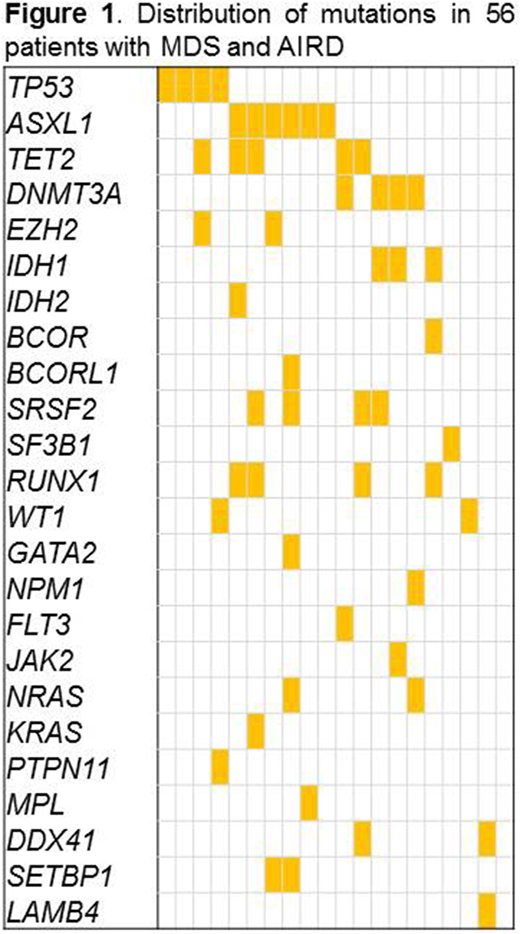Abstract
Introduction: A subset of patients with MDS and related myeloid disorders present with concomitant autoimmune rheumatological diseases (AIRD); however the prevalence ranges from 10-48% based on limited literature. Further, use of immunosuppressive agents in AIRD patients could confound the secondary diagnosis of MDS and in some cases cause it (therapy-related myeloid neoplasm; t-MN). The prevalence of cytopenia in AIRD patients is unknown and the genetic characteristics of MDS patients with concomitant AIRD have not been described. Hence, we interrogated two large multi-institutional databases -Royal Adelaide Hospital Rheumatology Database (RAH-RD) and South-Australian MDS (SA-MDS) registry in this study.
Methods: Demographic, clinical, laboratory and treatment data of 2663 AIRD and 1157 MDS patients were analysed. In AIRD patients (autoimmune inflammatory arthritis, spondyloarthritis, vasculitis and connective tissue diseases), cytopenia (persisting >6 months) were defined as follows: hemoglobin <100g/dL, absolute neutrophil <1800/mm3 and platelet <100,000/mm3. Targeted massively parallel sequencing of a custom panel of 43 myeloid neoplasms associated genes and 20 Fanconi (FA) DNA repair pathway genes (all coding regions) was performed on diagnosis bone marrow samples (n=237). An in-house well established filtering pipeline was used for identification of somatic mutations. Matched germline material was available for 62/194 (32%) patients. Only variants with Genome Aggregation Database minor allele frequency of ≤0.01% and variant allele frequency of ≥35% were selected for further analysis of germline variants.
Results: During follow up of 2663 AIRD patients, 36 (1.3%) patients satisfied the criteria for at least one cytopenia. Anemia (19/36, 53%) was most common followed by neutropenia (8/36, 22%), thrombocytopenia (4/36, 11%) and bi-cytopenia (5/36, 14%). Twenty-two patients had bone marrow examination which was non-diagnostic in 16 patients, while 7/2663 (0.3%) patients were diagnosed with MDS. Importantly, 5 patients with MDS and 11 patients with cytopenia did not receive any cytotoxic agents.
In the MDS database, 69(5.4%) were diagnosed with AIRD, with rheumatoid arthritis (n=20, 29%) being the most common AIRD. Among these 69 patients, 24 (34.8%) had low risk MDS and 15 (21.7%) had higher risk MDS. The remaining 30 patients had t-MN (n=19, 27.5%), MDS/MPN (n=8, 11.6%) and AML (n=3, 4.3%). Overall, in a combined population of 2663 RAH-RD and 1157 SA-MDS, 76(2%) had concomitant MDS and AIRD.
Genetic profile of patients with MDS and AIRD: The cytogenetic and mutational profile of MDS patients with (n=20) or without (n=217) AIRD were compared. No significant difference was seen in the cytogenetic profile (normal, complex or monosomal karyotype, chr. 5 or 7 abnormalities) between the two groups but in mutational analysis, 56 mutations were seen in 20 MDS patients with AIRD (Fig1). In these patients, mutations in epigenetic pathways were most common (23/56, 41%) followed by transcription pathway (10/56, 18%). Splicing mutations were seen in 5 patients, with SRSF2 mutations being more common than SF3B1. Mutations in TP53 were present in 4 (24%) patients; 3/4 patients developed MDS following therapy for AIRD (t-MDS). IDH1 mutations were found in significantly higher frequency in MDS patients with AIRD compared to MDS without AIRD (30% vs 3%, p=0.04). There was no significant difference in the frequency of other mutations or overall mutation frequency between the two groups.
Interestingly, 2 (10%) patients with MDS and AIRD also had rare, deleterious germline mutations in FA pathway genes (BRCA2 V2601M and L2512F) which could suggest either genetic predisposition to both these conditions or compromised DNA repair capability increasing susceptibility to t-MN.
Conclusions: In a large multi-institutional cohort of autoimmune rheumatological disorders, 1.3% patients developed persistent cytopenia with 0.3% diagnosed with MDS. This is significantly higher than incidence of MDS in the general population (30-50/100,000). Similarly, 5% MDS patients had AIRD. The mutation profile of MDS patients with AIRD shows higher frequency of IDH1 and SRSF2 mutations. A small proportion of cases also had deleterious rare germline mutations in the DNA repair pathway. Our findings warrant further study and have potential implications for selection of immunosupressive agents for AIRD.
Hiwase:Novartis: Research Funding; Celgene: Research Funding.
Author notes
Asterisk with author names denotes non-ASH members.


This feature is available to Subscribers Only
Sign In or Create an Account Close Modal